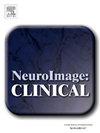Post-stroke outcome prediction based on lesion-derived features
IF 3.6
2区 医学
Q2 NEUROIMAGING
引用次数: 0
Abstract
Stroke-induced deficits result from both focal structural damage and widespread network disruption. This study investigated whether simulated measures of network disruption, derived from structural lesions, could predict functional impairments in stroke patients. We extracted four lesion-derived feature sets: lesion masks, probabilistic structural disconnection maps (pSDMs), structural and indirectly estimated functional connectivity strengths between brain regions, and topological properties of functional and structural brain networks to predict motor, executive, and processing speed deficits in 340 S patients, employing PCA-based ridge regression with leave-one-out cross validation.
The findings revealed that both structural disconnection map patterns and lesion masks were strong predictors of functional deficits. Lesion masks exhibited superior predictive performance relative to unthresholded pSDMs. Furthermore, applying a probability threshold to the pSDMs − retaining only disconnections present in a sufficient proportion of healthy subjects − significantly improved predictive performance. For motor deficits, thresholded SDMs (tSDMs) with thresholds of 0.9 and 0.5 produced the highest R2 values, 0.95 for left motor deficits and 0.69 for right motor deficits, respectively. In the case of executive function and processing speed, the highest R2 values were 0.58 and 0.64, achieved with tSDM thresholds of 0.3 and 0.5, respectively. Connectome-based features exhibited lower R2 values, with structural connection strength alterations showing stronger associations with post-stroke scores compared to changes in functional connectivity. Nodal parameters (degree and clustering coefficient) had lower explanatory power than the SDM features and lesion masks.
Our findings underscore the effectiveness of lesion masks and thresholded SDMs in predicting post-stroke deficits. This study contributes to the growing body of evidence supporting the reliability of simulated structural networks as a complementary approach to lesion patterns and structural disconnection in predicting post-stroke outcomes.
基于病变衍生特征的脑卒中后预后预测
中风引起的缺陷是由局灶性结构损伤和广泛的网络中断引起的。这项研究调查了是否模拟测量网络中断,源自结构病变,可以预测中风患者的功能损伤。我们提取了四个病变衍生的特征集:病变面具,概率结构断开图(pSDMs),大脑区域之间的结构和间接估计的功能连接强度,以及功能和结构脑网络的拓扑特性,以预测340例S患者的运动,执行和处理速度缺陷,采用基于pca的脊回归和遗漏交叉验证。研究结果表明,结构断开图模式和损伤掩模都是功能缺陷的有力预测因子。相对于无阈值pSDMs,病变掩模表现出更好的预测性能。此外,对psdm应用概率阈值(仅保留足够比例的健康受试者中存在的断开连接)可显著提高预测性能。对于运动缺陷,阈值为0.9和0.5的阈值SDMs产生的R2值最高,左侧运动缺陷和右侧运动缺陷分别为0.95和0.69。在执行功能和处理速度方面,当tSDM阈值分别为0.3和0.5时,R2值最高为0.58和0.64。基于连接体的特征表现出较低的R2值,与功能连接的变化相比,结构连接强度的改变与卒中后评分的关联更强。节点参数(度和聚类系数)的解释能力低于SDM特征和病变掩模。我们的研究结果强调了病变掩模和阈值SDMs在预测脑卒中后缺陷方面的有效性。这项研究提供了越来越多的证据,支持模拟结构网络作为预测脑卒中后预后的损伤模式和结构断开的补充方法的可靠性。
本文章由计算机程序翻译,如有差异,请以英文原文为准。
求助全文
约1分钟内获得全文
求助全文
来源期刊

Neuroimage-Clinical
NEUROIMAGING-
CiteScore
7.50
自引率
4.80%
发文量
368
审稿时长
52 days
期刊介绍:
NeuroImage: Clinical, a journal of diseases, disorders and syndromes involving the Nervous System, provides a vehicle for communicating important advances in the study of abnormal structure-function relationships of the human nervous system based on imaging.
The focus of NeuroImage: Clinical is on defining changes to the brain associated with primary neurologic and psychiatric diseases and disorders of the nervous system as well as behavioral syndromes and developmental conditions. The main criterion for judging papers is the extent of scientific advancement in the understanding of the pathophysiologic mechanisms of diseases and disorders, in identification of functional models that link clinical signs and symptoms with brain function and in the creation of image based tools applicable to a broad range of clinical needs including diagnosis, monitoring and tracking of illness, predicting therapeutic response and development of new treatments. Papers dealing with structure and function in animal models will also be considered if they reveal mechanisms that can be readily translated to human conditions.
 求助内容:
求助内容: 应助结果提醒方式:
应助结果提醒方式:


